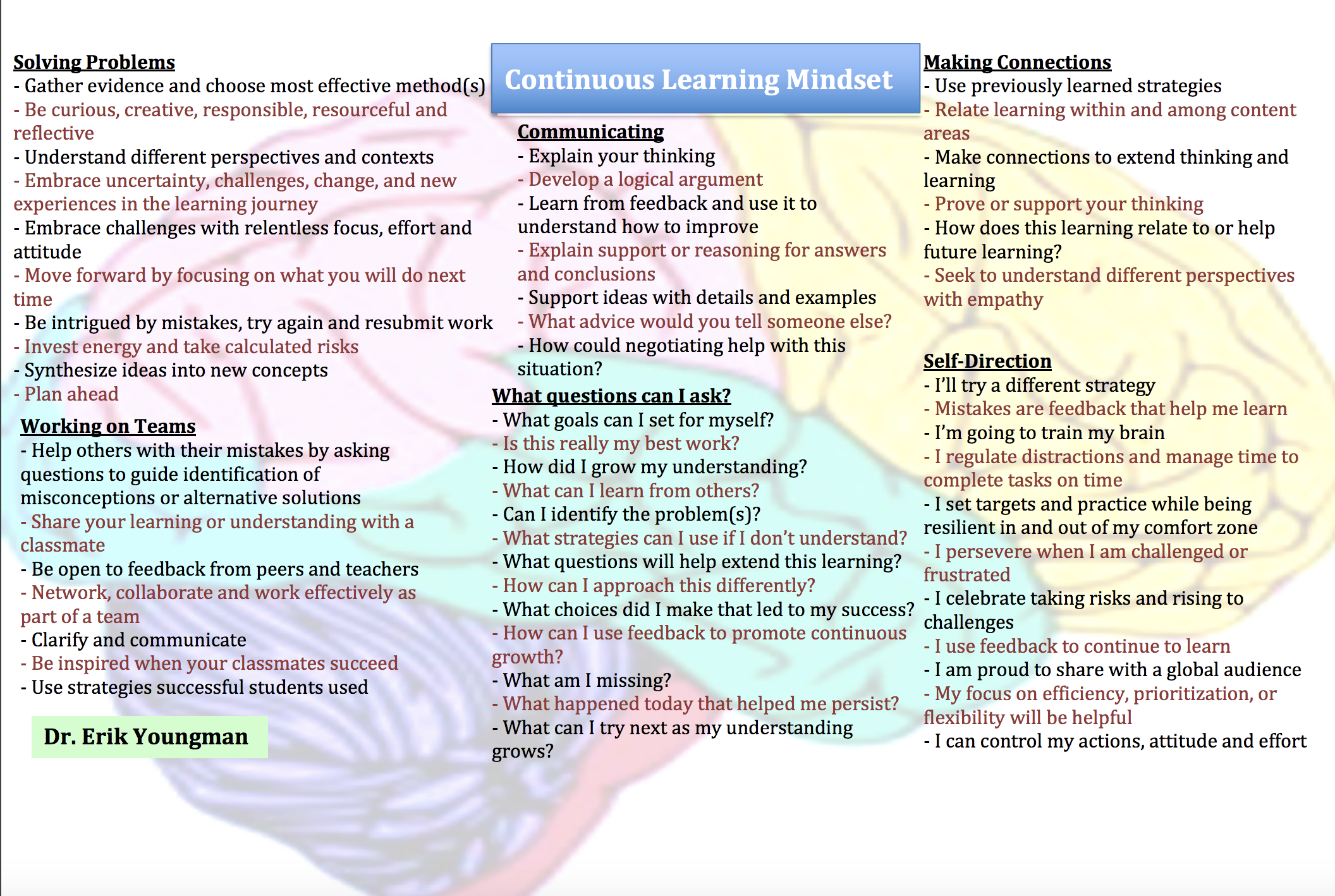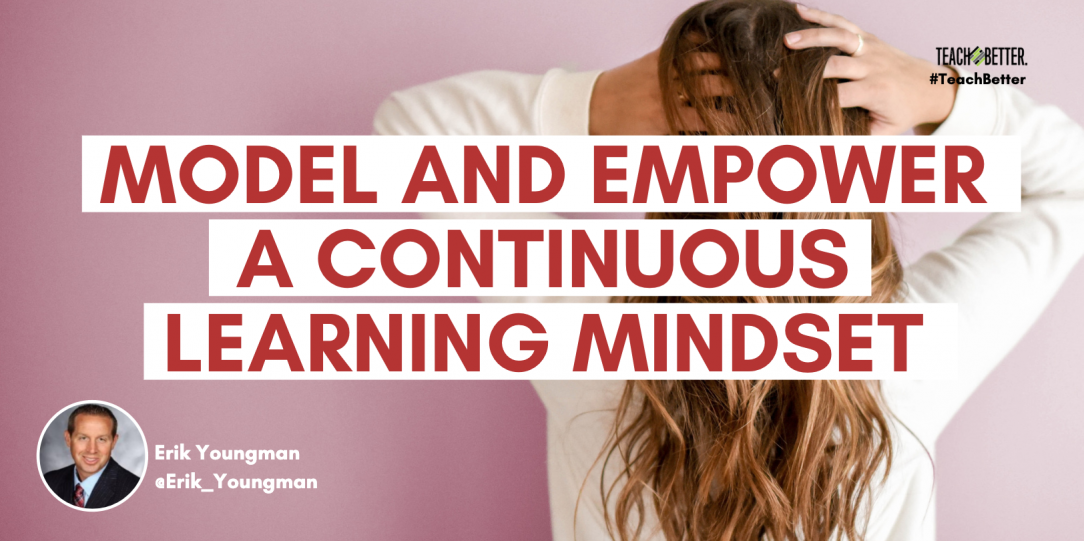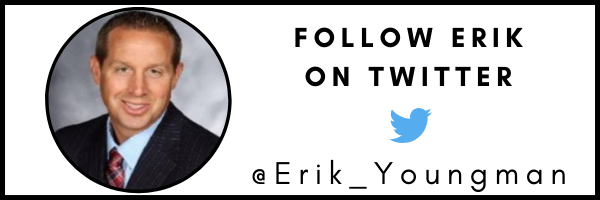TL;DR:
- An introduction to the continuous learning mindset.
- In depth discussion of all 6 components of a continuous learning mindset.
- Guiding questions to develop or improve a continuous learning mindset.
Carol Dweck has shared a variety of research and recommendations about growth mindset. My experiences as an educator, parent, athlete, and coach have shaped my focus toward the benefits of modeling and empowering a growth mindset.
Merging research about growth mindset with the structure of the Applications of Learning created by the Illinois State Board of Education provides a lens to view a  new topic: Continuous Learning Mindset.
new topic: Continuous Learning Mindset.
The Continuous Learning Mindset focuses on the six dimensions of solving problems, communicating, and making connections. It also includes questions that can be asked, self-direction, and working on teams.
These six dimensions provide specific analysis and actions that enhance the effectiveness of thinking.
The summaries below will model different ways that a Continuous Learning Mindset can guide a variety of growth mindset actions, attitudes, and behaviors. Each summary includes why the dimension is important, 1-4 guiding statements or questions, and additional ways to improve.
Use the six dimensions of a Continuous Learning Mindset to model and empower reflection, courage, perseverance, and empathy. Click To TweetDimension #1: Solving Problems
Solving problems with a Continuous Learning Mindset includes resourcefulness, taking time to think, and reflecting about different strategies.
It requires perseverance and monitoring effort to progress through productive struggle and cognitive dissonance.
Two guiding statements regarding solving problems are:
- Embrace uncertainty, challenges, change, and new experiences in the learning journey.
- Be curious, creative, responsible, resourceful and reflective.
Some additional suggestions for problem solving are:
- Gather evidence and choose the most effective method(s).
- Understand different perspectives and contexts.
- Take on challenges with relentless focus, effort, and attitude.
- Move forward by focusing on what you will do next time.
- Be intrigued by mistakes, try again and resubmit work.
- Invest energy and take calculated risks.
- Synthesize ideas into new concepts.
- Plan ahead.
Dimension #2: Communicating
Communicating with a Continuous Learning Mindset enhances focus on communication and listening skills.
Examples include sharing advice, encouragement, explanations, and feedback. It also includes listening with curiosity, empathy, and for the purpose of learning. Communicating with a Continuous Learning Mindset also includes articulating feelings and asking the correct questions to the correct people at the correct time.
A guiding statement regarding communicating is:
- Learn from feedback and use it to understand how to improve.
Some additional suggestions for communicating with a continuous learning mindset are:
- Explain your thinking.
- Develop a logical argument.
- Explain support or reasoning for answers and conclusions.
- Support ideas with details and examples.
It can also be helpful to ask reflective questions while communicating with a continuous learning mindset. Some helpful questions to guide reflection are:
- What advice would you tell someone else?
- How could negotiating help with this situation?
Dimension #3: Making Connections
Making Connections with a Continuous Learning Mindset sparks reflection about previous experiences. This, in turn, enhances efficiency, performance, growth, and success. Making connections also inspires opportunities to explore passions, strengths, and perspectives.
Two guiding statements regarding making connections are:
- Make connections to extend thinking and learning.
- Seek to understand different perspectives with empathy.
When making connections, it’s also helpful to:
- Use previously learned strategies.
- Relate learning within and among content areas.
- Prove or support your thinking.
- Ask yourself: How does this learning relate to or help future learning?

Dimension #4: What Questions Can I Ask?
Discussing potential questions that can be asked empowers reflection or improvement for yourself and others. Questions can enhance curiosity and understanding of different perspectives. This then guides self-assessment of progress and growth.
Three questions that can be asked are:
- Which strategies can I use if I don’t understand?
- What choices did I make that led to my success?
- How can I use feedback to promote continuous growth?
Some additional questions that can be asked to promote reflection are:
- What goals can I set for myself?
- How did I grow my understanding?
- What can I learn from others?
- Can I identify the problem(s)?
- What questions will help extend this learning?
- How can I approach this differently?
- What am I missing?
- Is this really my best work?
- What happened today that helped me persist?
- How did you grow?
- What can I try next as my understanding grows?
Dimension #5: Self-Direction
Self-Direction with a Continuous Learning Mindset empowers self-talk, growth, motivation, and self-assessment.
Self-talk topics include emotional intelligence, cognitive flexibility, confidence in being yourself, and the belief in the capacity to successfully complete a task, also known as self-efficacy.
Growth topics include learning from failure and choosing the right attitude.
Motivation topics enhance confidence, courage, perseverance, and response to mistakes or surprises.
Self-assessment topics include sustaining focus and prioritizing strategies, while monitoring growth targets and goals. Self-assessment also includes recognizing what people have control over compared to what they don’t. For example, people don’t have control over adversity or other people’s actions, feelings, or opinions. However, people can control their attitude, effort, and actions.
Five guiding statements regarding self-direction are:
- Mistakes are feedback that help me learn.
- I set targets and practice while being resilient.
- When I am challenged or frustrated, I persevere.
- My focus on efficiency, prioritization, or flexibility will be helpful.
- I can control my actions, attitude and effort.
These five statements effectively focus on the development of a greater sense of self-direction.
Some additional guiding statements to help grow self-direction or self-talk are:
- I’ll try a different strategy.
- I’m going to train my brain.
- To complete tasks on time, I regulate distractions and manage time.
- I celebrate taking risks and rising to challenges.
- I’ll use this feedback to continue to learn.
- I am proud to share with a global audience.
Dimension #6: Working on Teams
Working on teams with a Continuous Learning Mindset focuses on helping, collaborating with, learning from, and being inspired by others. The result is a supportive, respectful, and trusting culture. One that includes shared ownership and a belief in abilities to positively affect others, or collective efficacy.
A guiding statement regarding working on teams is:
- Network, collaborate, and work effectively as part of a team.
This simple statement can facilitate reflection, discussion, as well as personal growth.
Some additional guiding statements to improve teamwork are:
- Help others with their mistakes by asking questions to guide identification of misconceptions or alternative solutions.
- Share your learning or understanding with a classmate.
- Be open to feedback from peers and teachers.
- Clarify and communicate.
- Be inspired when your classmates succeed.
- Use strategies successful students used.
Summary
Use the six dimensions of a Continuous Learning Mindset to model and empower reflection, courage, perseverance, and empathy.
Ask questions and motivate yourself and others to be cognizant of how these dimensions guide growth, improvement, and success with a Continuous Learning Mindset. I would love to hear feedback and questions via Twitter (@Erik_Youngman) so we can collaboratively empower kids and adults to utilize a Continuous Learning Mindset.
About Erik Youngman
Erik Youngman is an education leader who is passionate about topics such as homework, grading, leadership, and growth mindset. He recently completed his nineteenth year in educational leadership. Erik is the Director of Curriculum, Instruction, and Assessment for Libertyville District 70 in Libertyville, Illinois. Previous education experiences include being a principal in Libertyville as well as an assistant principal and teacher in Gurnee, Illinois.
Erik earned a Doctorate in Educational Leadership, Education Specialist Degree, and Master of Science in Education from Northern Illinois University and a Bachelor of Arts from Augustana College. Please follow and contact Erik via Twitter: @Erik_Youngman.



